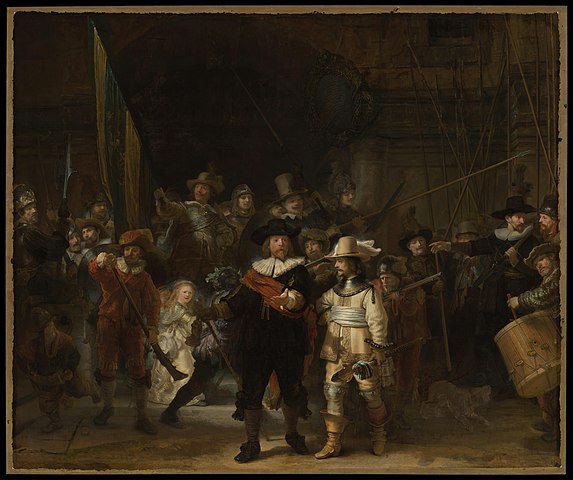
Title: The Night Watch
Artist: Rembrandt van Rijn
Date Painted: 1642
Medium: Oil on Canvas
Period: Baroque, Dutch Golden Age
Dimensions: 363cm x 437cm
Location: Amsterdam Museum on permanent loan to Rijksmuseum
Summary of The Night Watch
The Night Watch, officially titled “Militia Company of District II under the Command of Captain Frans Banninck Cocq,” is one of Rembrandt van Rijn’s most famous works, completed in 1642. This masterpiece is renowned for its colossal size, measuring approximately 3.63 meters by 4.37 meters, and for the innovative techniques Rembrandt employed to convey this dynamic and dramatic scene. The painting is housed in the Rijksmuseum in Amsterdam, making it one of the most celebrated pieces of the Dutch Golden Age of painting.
The artwork depicts a city guard as they move out, led by Captain Frans Banninck Cocq and his lieutenant, Willem van Ruytenburch. Contrary to the painting’s popular title, it does not depict a nighttime scene; instead, the dark background seen today is the result of varnish that has darkened over time. The scene is actually set in daylight, and recent cleanings have restored some of its original brightness and detail.
What makes The Night Watch particularly remarkable is Rembrandt’s use of light and shadow to create a sense of depth and movement, a technique known as chiaroscuro. Rembrandt positioned his figures in a dynamic, almost theatrical arrangement, breaking away from the traditional static and formal group portraits of the time. He skillfully manipulated light to fall across the scene, highlighting key figures and creating a vivid sense of realism and immediacy.
At the center of the composition are Captain Cocq, dressed in black with a red sash, and Lieutenant van Ruytenburch, in a bright yellow dress, leading the militia. Their illuminated figures draw the viewer’s eye, serving as a focal point amidst the bustling activity of the guardsmen preparing for action. Each character in the painting, from the foreground to the background, is depicted with individuality and detail, contributing to the narrative of a mobilized militia.
The painting is also notable for its symbolic elements and hidden details. For example, the little girl in the background, illuminated and dressed in yellow, is believed to represent the mascot of the militia company, carrying the claws of a dead chicken on her belt, symbolizing the defeat of enemies. The dog at the bottom right of the painting adds to the liveliness of the scene, barking at the commotion.
The Night Watch is a celebration of civic pride, a tribute to the democratic ideals of the young Dutch Republic, and a demonstration of Rembrandt’s mastery of painting. Its innovative composition, use of light, and attention to detail not only marked a departure from traditional group portraits but also established it as a monumental work in the history of art.
The Composition of The Night Watch
The composition of Rembrandt’s “The Night Watch” is a masterpiece of complexity, depth, and dynamism, setting it apart from the static and formal group portraits typical of the 17th century. Rembrandt van Rijn masterfully orchestrated the scene to capture a moment of action and readiness, creating a vivid narrative through his use of spatial organization, light, and character interaction. Here’s a breakdown of its composition:
Central Figures
- Captain Frans Banninck Cocq: Dressed in black with a red sash, he is positioned slightly left of center. His outstretched hand leads the viewer’s gaze into the composition, symbolizing his command over the militia.
- Lieutenant Willem van Ruytenburch: Clad in a bright yellow coat, standing next to Cocq, his attire contrasts sharply against the darker tones, making him a focal point and illuminating the central area of the painting.
Use of Light
- Chiaroscuro: Rembrandt’s use of light and shadow (chiaroscuro) is a defining feature. The dramatic illumination highlights the central figures and creates a sense of depth and volume. This technique guides the viewer’s eye through the painting, emphasizing the movement and the three-dimensionality of the scene.
- Spotlight Effect: The contrast between the brightly lit figures and the shadowed background enhances the theatricality of the scene, making it feel alive and dynamic.
Dynamic Composition
- Diagonal Lines and Depth: The composition is organized along diagonal lines that create a sense of depth and perspective. The figures are staggered and overlap, moving from the brightly lit foreground to the shadowed background, which draws the viewer’s eye into the scene.
- Grouping and Action: Unlike static portraits, the figures in “The Night Watch” are captured in mid-action, contributing to a narrative of readiness and movement. The arrangement of the figures, from the musketeers preparing their weapons to the drummer beating his drum, suggests a moment just before marching.
Symbolism and Detail
- Little Girl: Among the figures, a little girl appears illuminated in the background, symbolizing the militia’s emblem with a chicken claw hanging from her belt, representing the clauweniers (arquebusiers).
- Dog: At the bottom right, a small dog barks, adding to the liveliness and realism of the scene, possibly symbolizing loyalty or alertness.
Depth and Perspective
- Rembrandt employs atmospheric perspective to create depth, with the figures becoming less defined and more engulfed in shadow as they recede into the background. This technique, combined with the strategic use of light, makes the space appear larger and more dynamic.
The Night Watch is not just a group portrait; it is a narrative piece that tells a story through its composition. Rembrandt’s innovative approach to composition, his masterful use of light, and the painting’s dynamic arrangement revolutionized portrait painting and left a lasting impact on the history of art.